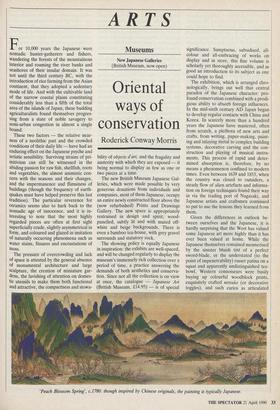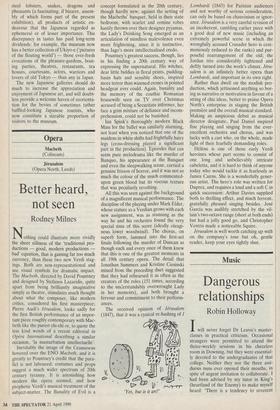ARTS
Museums
New Japanese Galleries (British Museum, now open)
Oriental ways of conservation
Roderick Conway Morris
For 10,000 years the Japanese were nomadic hunter-gatherers and fishers, wandering the forests of the mountainous interior and roaming the river banks and seashores of their insular domain. It was not until the third century BC, with the introduction of rice farming from the Asian continent, that they adopted a sedentary mode of life. And with the cultivable land of the narrow coastal plains constituting considerably less than a fifth of the total area of the islands of Japan, these budding agriculturalists found themselves progres- sing from a state of noble savagery to semi-urban congestion in almost a single bound.
These two factors — the relative near- ness of a neolithic past and the crowded conditions of their daily life — have had an enduring effect on the Japanese psyche and artistic sensibility. Surviving strains of pri- mitivism can still be witnessed in the abiding passion for raw fish, shellfish, roots and vegetables, the almost animistic con- cern with the seasons and their changes, and the impermanence and flimsiness of buildings (though the frequency of earth- quakes must have helped preserve this last tradition). The particular reverence for ceramics seems also to hark back to the nomadic age of innocence, and it is in- teresting to note that the most highly regarded pieces are often at , first sight superficially crude, slightly asymmetrical in form, and coloured and glazed in imitation of naturally occurring phenomena such as water stains, fissures and encrustations of moss.
The pressure of overcrowding and lack of space is attested by the general absence of monumental architecture and large sculpture, the creation of miniature gar- dens, the lavishing of attention on domes- tic utensils to make them both functional and attractive, the compactness and stowa- bility of objects d'art, and the frugality and austerity with which they are exposed — it being normal to display as few as one or two pieces at a time.
The new British Museum Japanese Gal- leries, which were made possible by very generous donations from individuals and companies, most of them Japanese, occupy an entire newly constructed floor above the (now refurbished) Prints and Drawings Gallery. The new space is appropriately restrained in design and spirit; wood- panelled, subtly lit and with muted off- white and beige backgrounds. There is even a bamboo tea-house, with grey gravel surrounds and statutory rock.
The showing policy is equally Japanese in inspiration: the exhibits are well-spaced, and will be changed regularly to display the museum's immensely rich collection over a period of time, a practice answering the . demands of both aesthetics and conserva- tion. Since not all the collection is on view at once, the catalogue — Japanese Art (British Museum, £14.95) — is of special significance. Sumptuous, subsidised, all- colour and all-embracing of works on display and in store, this fine volume is scholarly yet thoroughly accessible, and as good an introduction to its subject as one could hope to find.
The exhibition, which is arranged chro- nologically, brings out well that central paradox of the Japanese character: pro- found conservatism combined with a prodi- gious ability to absorb foreign influences. In the mid-sixth century AD Japan began to develop regular contacts with China and Korea. In scarcely more than a hundred years the Japanese have mastered, often from scratch, a plethora of new arts and crafts, from writing, paper-making, paint- ing and inlaying metal to complex building systems, decorative carving and the con- struction and playing of musical instru- ments. This process of rapid and deter- mined absorption is, therefore, by no means a phenomenon confined to modern times. Even between 1639 and 1853, when the country was closed to outsiders, a steady flow of alien artefacts and informa- tion on foreign techniques found their way in via the trading port of Nagasaki, and Japanese artists and craftsmen continued to put to use the lessons they learned from them.
Given the differences in outlook be- tween ourselves and the Japanese, it is hardly surprising that the West has valued some Japanese art more highly than it has ever been valued at home. While the Japanese themselves remained mesmerised by the sinister bluish tint of a perfect sword-blade, or the understated (to the point of impenetrability) russet patina on a squat and apparently undistinguished tea- bowl, Western connoiseurs were busily buying up colourful woodblock prints, exquisitely crafted netsuke (or decorative toggles), and such curios as articulated `Peach Blossom Spring', c.1780: though inspired by Chinese originals, the painting is typically Japanese. steel lobsters, snakes, dragons and pheasants (a fascinating, if bizarre, assem- bly of which forms part of the present exhibition), all products of artistic en- deavour that the Japanese regarded as ephemeral or of lesser importance. This discrepancy in tastes has paid long-term dividends: for example, the museum now has a better collection of Ukiyo-e (`pictures of the floating world') — those ever-fresh evocations of the pleasure-gardens, boat- ing parties, theatres, restaurants, tea houses, courtesans, actors, warriors and lovers of old Tokyo — than any in Japan.
The new Japanese galleries should do much to increase the appreciation and enjoyment of Japanese art, and will doubt- less provide a welcome haven of reorienta- tion for the bevies of sometimes rather baffled-looking Japanese tourists, who now constitute a sizeable proportion of visitors to the museum.



















































 Previous page
Previous page